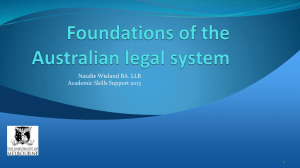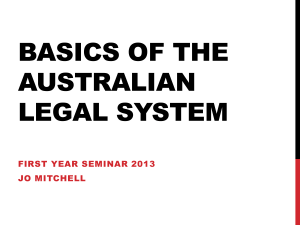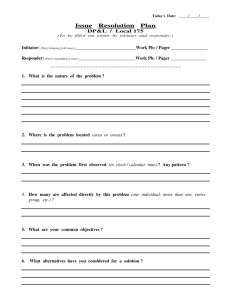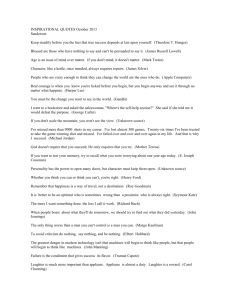question one
advertisement
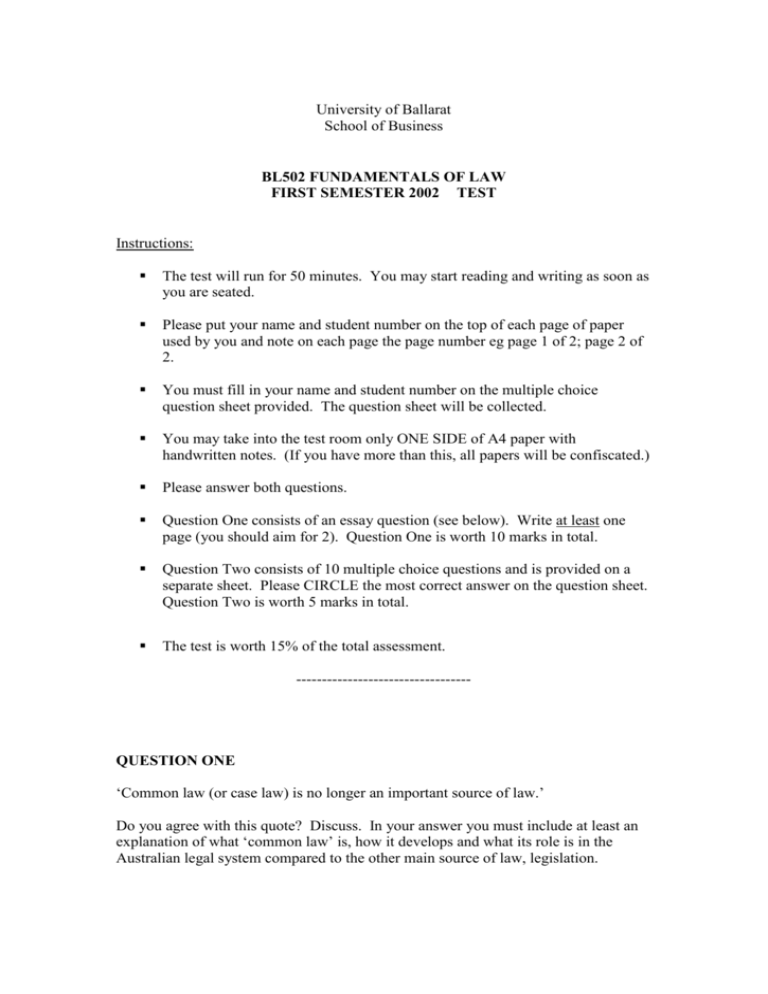
University of Ballarat School of Business BL502 FUNDAMENTALS OF LAW FIRST SEMESTER 2002 TEST Instructions: The test will run for 50 minutes. You may start reading and writing as soon as you are seated. Please put your name and student number on the top of each page of paper used by you and note on each page the page number eg page 1 of 2; page 2 of 2. You must fill in your name and student number on the multiple choice question sheet provided. The question sheet will be collected. You may take into the test room only ONE SIDE of A4 paper with handwritten notes. (If you have more than this, all papers will be confiscated.) Please answer both questions. Question One consists of an essay question (see below). Write at least one page (you should aim for 2). Question One is worth 10 marks in total. Question Two consists of 10 multiple choice questions and is provided on a separate sheet. Please CIRCLE the most correct answer on the question sheet. Question Two is worth 5 marks in total. The test is worth 15% of the total assessment. ---------------------------------- QUESTION ONE ‘Common law (or case law) is no longer an important source of law.’ Do you agree with this quote? Discuss. In your answer you must include at least an explanation of what ‘common law’ is, how it develops and what its role is in the Australian legal system compared to the other main source of law, legislation. University of Ballarat - School of Business BL502 FUNDAMENTALS OF LAW TEST QUESTION TWO - MULTIPLE CHOICE QUESTIONS NAME…………………………………………… STUDENT NO…………………. Please circle the most correct answer. Question 1 What type of law would NOT be considered to be private law: (a) contract law (b) taxation law (c) the law of torts (d) property law Question 2 The system of dispute resolution that operates in Australian Courts is: (a) the civil law system (b) the mediation system (c) the adversarial system (d) the inquisitorial system Question 3 A legal principle, or statement made by a judge, which is not part of the reason for the decision, is described as: (a) ejusdem generis; (b) obiter dicta; (c) ratio decidendi (d) stare decisis. Question 4 The separation of powers describes: (a) separation of legislative powers between the Commonwealth and State Parliaments (b) the process by which Australia became a federation (c) the separation of powers between the courts, the executive and the legislative. Question 5 If a new dispute is being heard in the Supreme Court of Victoria, which of the following would be a binding precedent? (a) the case of A v B heard in 1999 in Supreme Court of Victoria; the facts are similar (b) the case of C v D heard in 1995 in the Appeal Court of the Supreme Court of New South Wales; the facts are similar (c) the case of E v F heard in 1993 in the County Court of Victoria; the facts are similar (d) the case of F v G heard in 1998 in the High Court of Australia; the facts are not similar (e) none of the above. Question 6 Which is the correct case citation: (a) Walton Stores (Interstate) Ltd. v Maher and Another (1988) 164 CLR (b) Walton Stores (Interstate ) Ltd. v Maher and Another 164 CLR (1988) 387 (c) Walton Stores (Interstate) Ltd. v Maher and Another 164 (1988) CLR 387 (d) Walton Stores (Interstate) Ltd. v Maher and Another (1988) 164 CLR 387 Question 7 The Commonwealth Parliament passed the Trade Practices Act 1974 relying on its powers under s.51 of the Constitution to make laws with respect to: (a) advertising, consumer protection and competition (b) trading, financial and foreign corporations, interstate and overseas trade and postal, telegraphic and telephonic services (c) trading, financial and foreign corporations (d) none of the above. Question 8 An appeal court ‘overrules’ a previous decision when it: (a) does not agree with the lower court who made a decision in that same case (b) does not agree with the decision of a lower court in a previous case (c) decides that the facts of a previous case are not similar, so the ratio will not apply (d) doesn’t like the decision of a lower court in a previous case. Question 9 Which is the correct statement of interpretative aids to assist in statutory interpretation: (a) words will be limited by the context in which they appear (b) where general phrases follow specific words of the same kind, the general phrase is to be limited in meaning to the things of that same kind (c) where one person or matter is referred to, everyone or everything else should be excluded (d) all of the above (e) (a) and (b) only (f) none of the above Question 10 The purpose approach to statutory interpretation: (a) states that where a literal interpretation would lead to an inconsistency, or absurdity, then the words should be given a meaning that would avoid the absurdity (b) looks to the overall intention of parliament by reading the whole statute (c) allows the use of extrinsic materials in the interpretation of statutes (d) looks to the overall intention of Parliament by seeking to discover the intention of Parliament when it passed the Act and then giving effect to it University of Ballarat School of Business BL502 FUNDAMENTALS OF LAW FIRST SEMESTER 2002 MEDICAL SUPPLMENTARY TEST Instructions: The test will run for 50 minutes. You may start reading and writing as soon as you are seated. Please put your name and student number on the top of each page of paper used by you and note on each page the page number eg page 1 of 2; page 2 of 2. You must fill in your name and student number on the multiple choice question sheet provided. The question sheet will be collected. You may take into the test room only ONE SIDE of A4 paper with handwritten notes. (If you have more than this, all papers will be confiscated.) Please answer both questions. Question One consists of an essay question (see below). Write at least one page (you should aim for 2). Question One is worth 10 marks in total. Question Two consists of 10 multiple choice questions and is provided on a separate sheet. Please CIRCLE the most correct answer on the question sheet. Question Two is worth 5 marks in total. The test is worth 15% of the total assessment. ---------------------------------- QUESTION ONE ‘It is not the Courts’ role to make law; that is the role of Parliament.’ Do you agree with this quote? Discuss. University of Ballarat - School of Business BL502 FUNDAMENTALS OF LAW TEST QUESTION TWO - MULTIPLE CHOICE QUESTIONS NAME…………………………………………… STUDENT NO…………………. Please circle the most correct answer. Question 1 Which is a correct statement? (a) In a criminal case the judge or jury have to be convinced by the prosecution on the balance of probabilities that the accused was guilty (b) In a civil case the judge or jury have to be convinced by the prosecution on the balance of probabilities that the plaintiff was guilty (c) In a civil case the judge or jury have to be convinced on the balance of probabilities by the defendant that it has the best case (d) In a civil case the judge or jury have to be convinced on the balance of probabilities by the plaintiff that it has the best case Question 2 When a judge ‘distinguishes’ a precedent case it means: (a) the judge disagrees with the ratio of the precedent case which was made in a lower court and states that he/she will not follow it; (b) the facts of the present case and the precedent case are not sufficiently similar; (c) the precedent was made by a lower court and therefore is not binding. Question 3 ‘Concurrent powers’ are: (a) those listed in the Australian Constitution which can be exercised by the Commonwealth Parliament only; (b) those listed in the Australian Constitution which can be exercised by the States only; (c) those listed in s. 51 of the Constitution which can be exercised by the Commonwealth only if the States have not used them; (d) those listed in s.51 of the Constitution which can be exercised by the States only if the Commonwealth have not used them. Question 4 The division of powers describes: (a) the division of judicial powers between the Commonwealth and the State Courts; (b) the process by which Australia became a federation; (c) the division of powers between the courts, the executive and the legislative; (d) none of the above. Question 5 If a new dispute is being heard in the Supreme Court of Victoria, which of the following would be a binding precedent? (a) the case of A v B heard in 1990 in the Appeal Court of the Supreme Court of Victoria; the facts are not similar (b) the case of C v D heard in 199`5 in the Appeal Court of the Supreme Court of Queensland; the facts are not similar (c) the case of E v F heard in 1993 in the County Court of Victoria; the facts are similar (d) the case of F v G heard in 1903 in the High Court of Australia; the facts are similar (e) none of the above. Question 6 A court approves a decision if it (a) agrees with the decision of the lower court in the same case (b) agrees with the decision of the of a lower court in a different previous case (c) agrees with the decision of a higher court in a different previous case (d) none of the above Question 7 In the case of Adler v George, the court said that the meaning of ‘in the vicinity of a prohibited place’ meant that to be guilty of the offence a person had to be (a) near but not in the prohibited place, using the literal rule (b) near but not in the prohibited place, using the golden rule (c) near or in the prohibited place, using the golden rule (d) near or in the prohibited place, using the purpose rule Question 8 The correct case citation is: (a) Donoghue v Stevenson [1932] AC (b) Donoghuev Stevenson AC [1932] 562 (c) Donoghue v Stevenson 562 [1932] AC (d) Donoghue v Stevenson [1932] AC 562 Question 9 An example of equity law is: (a) breach of contract (b) negligent misrepresentation (c) innocent misrepresentation, mistake and unconscionable dealing Question 10 A legal principle, or statement made by a judge, which is the reason for the decision, is described as: (a) ejusdem generis; (b) obiter dicta; (c) ratio decidendi (d) stare decisis.


